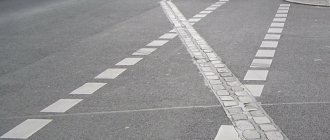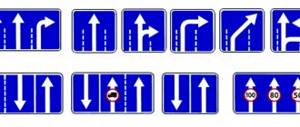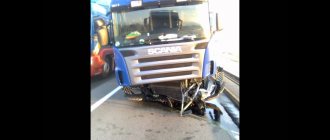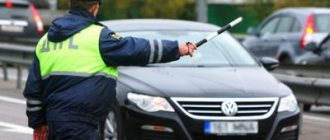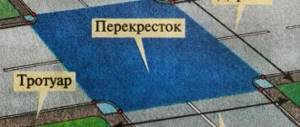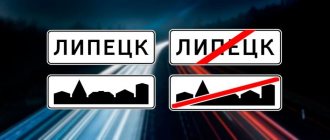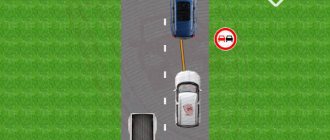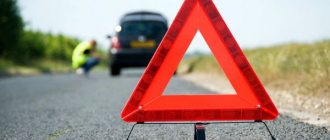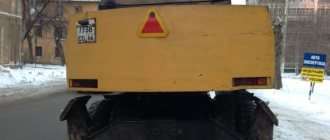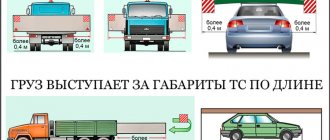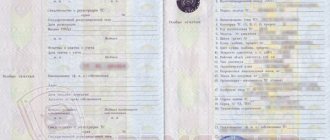9.2. On dual carriageway roads with four or more lanes, it is prohibited to overtake or pass into the lane intended for oncoming traffic. On such roads, left turns or U-turns may be made at intersections and in other places where this is not prohibited by the Rules, signs and (or) markings.
On four-lane roads, all lanes can be marked with markings (double solid line to separate oncoming traffic - 1.3 and dotted lines 1.5 or solid lines 1.1 to separate passing directions.
Four lanes are marked
- It is possible to designate only a double solid line - 1.3 in the center to separate the flows, while in accordance with the purpose of marking 1.3, the road will have four or more lanes.
Four lanes marked with double solid only
Determining a four-lane road without markings is possible only by knowing the exact width of the roadway. According to the standards, the width of each lane of such a road is 3.5 meters, but in some conditions it may be narrowed to 3 meters. Thus, the minimum width of two-sided
the roadway for the application of paragraph 9.2 of the Traffic Rules is 12 meters.
If there are no markings on two or three-lane roads, following paragraph 9.1 of the Rules, driving in four lanes is possible. These lanes are determined by drivers. Their number may vary depending on the size of the vehicles, the speed of travel and the selected safe interval. On the road, the number of lanes will be the same as designed and built. It is unlawful to apply paragraph 9.2 when qualifying violations on roads less than 12 meters wide.
Driver-defined lanes
All illustrations above show a typical road with four lanes and a width of 14 meters. The slower the speed, the denser the vehicles move.
The downside is that if driving on a four-lane road in the far right lane is impossible (road works, obstacles in the form of snowdrifts, etc.), such a road does not become narrower than the width of the obstacle.
The minimum width of a two-way carriageway with 4 lanes is 12 meters.
Transitional express lanes, additional ascending lanes, and drive-in pockets of route vehicle stopping places are not taken into account in accordance with clause 9.1 of the Rules.
Oncoming traffic is prohibited
Clause 9.2 establishes a ban on entering the oncoming lane to overtake or bypass - this list of maneuvers is limited and does not have any allowances for avoiding obstacles, even if this is impossible within the oncoming lane. In this case, it is impossible to bypass the obstacle without violating the Traffic Rules. Moreover, the presence or absence of markings does not matter. However, such a violation of the Rules will not entail an administrative offense, that is, it is unlawful to fine for such a violation.
Avoiding obstacles is prohibited by the Rules
It is possible to organize traffic in the oncoming lane on roads with dividing strips or tram tracks (more about tram tracks in the commentary to the term “Roadway”). For this purpose, road signs 6.19.1 or 6.19.2 are used - “Preliminary indicator for changing lanes onto another roadway.”
Organized departure into the oncoming lane
Chapter 9: Location of vehicles on the roadway
- Current as of 05/26/2021
- Revision dated November 24, 2018
- Approved 10/23/1993
9.1. The number of lanes for trackless vehicles is determined by markings and (or) signs 5.15.1, 5.15.2, 5.15.7, 5.15.8, and if there are none, then by the drivers themselves, taking into account the width of the roadway, vehicle dimensions and required intervals between them. In this case, the side intended for oncoming traffic on two-way roads without a dividing strip is considered to be half the width of the roadway located on the left, not counting local widenings of the roadway (transition and express lanes, additional lanes on the rise, drive-in pockets of stops for route vehicles ).
5.15.1
5.15.8
5.15.2
5.15.7
9.1(1). On any two-way roads, driving in the lane intended for oncoming traffic is prohibited if it is separated by tram tracks, a dividing strip, markings 1.1, 1.3 or markings 1.11, the broken line of which is located on the left.
9.2. On dual carriageway roads with four or more lanes, it is prohibited to overtake or pass into the lane intended for oncoming traffic. On such roads, left turns or U-turns may be made at intersections and in other places where this is not prohibited by the Rules, signs and (or) markings.
9.3. On two-way roads that have three lanes marked with markings (except for marking 1.9), of which the middle one is used for traffic in both directions, it is allowed to enter this lane only for overtaking, bypassing, turning left or making a U-turn. It is prohibited to enter the leftmost lane intended for oncoming traffic.
Markup 1.9
9.4. Outside populated areas, as well as in populated areas on roads marked with signs 5.1 or 5.3 or where driving at a speed of more than 80 km/h is permitted, vehicle drivers must drive them as close as possible to the right edge of the roadway. It is prohibited to occupy the left lanes when the right lanes are free.
| 5.1 | 5.3 |
In populated areas, taking into account the requirements of this paragraph and paragraphs 9.5, 16.1 and 24.2 of the Rules, vehicle drivers can use the lane that is most convenient for them. In heavy traffic, when all lanes are occupied, changing lanes is only allowed to turn left or right, make a U-turn, stop, or avoid an obstacle.
However, on any roads that have three or more lanes for traffic in a given direction, the leftmost lane is allowed to occupy only in heavy traffic, when other lanes are occupied, as well as for turning left or making a U-turn, and for trucks with a permissible maximum weight of more than 2.5 t - only for turning left or making a U-turn. Entering the left lane of one-way roads to stop and park is carried out in accordance with paragraph 12.1 of the Rules.
9.5. Vehicles whose speed should not exceed 40 km/h or which for technical reasons cannot reach such a speed must move in the far right lane, except in cases of detour, overtaking or changing lanes before turning left, making a U-turn or stopping in permitted cases on the left side roads.
9.6. It is allowed to travel on tram tracks in the same direction, located on the left at the same level as the roadway, when all lanes in this direction are occupied, as well as when making a detour, turning left or making a U-turn, taking into account clause 8.5 of the Rules. In this case, there should be no interference with the tram. It is prohibited to drive onto tram tracks in the opposite direction. If road signs 5.15.1 or 5.15.2 are installed in front of the intersection, movement on tram tracks through the intersection is prohibited.
| 5.15.1 | 5.15.2 |
9.7. If the roadway is divided into stripes by marking lines, the movement of vehicles must be carried out strictly along the designated lanes. It is allowed to drive over broken marking lines only when changing lanes.
9.8. When turning onto a road with reverse traffic, the driver must drive the vehicle in such a way that when leaving the intersection of roadways, the vehicle takes the far right lane. Changing lanes is permitted only after the driver is convinced that traffic in this direction is also permitted in other lanes.
9.9. The movement of vehicles on dividing strips and shoulders, sidewalks and pedestrian paths is prohibited (except for the cases provided for in paragraphs 12.1, 24.2 - 24.4, 24.7, 25.2 of the Rules), as well as the movement of motor vehicles (except mopeds) on lanes for cyclists. The movement of motor vehicles on bicycle and bicycle-pedestrian paths is prohibited. The movement of vehicles of road maintenance and utility services is allowed, as well as access along the shortest route for vehicles delivering cargo to trade and other enterprises and facilities located directly next to the roadsides, sidewalks or pedestrian paths, in the absence of other access options. At the same time, traffic safety must be ensured.
9.10. The driver must maintain such a distance from the vehicle in front that would allow him to avoid a collision, as well as the necessary lateral interval to ensure traffic safety.
9.11. Outside populated areas on dual carriageway roads with two lanes, the driver of a vehicle for which a speed limit has been established, as well as the driver of a vehicle (vehicle combination) longer than 7 m, must maintain such a distance between himself and the vehicle moving ahead that overtaking vehicles could move into the lane they previously occupied without interference. This requirement does not apply when driving on sections of roads where overtaking is prohibited, as well as during heavy traffic and movement in an organized transport convoy.
9.12. On two-way roads, in the absence of a dividing strip, traffic islands, bollards and elements of road structures (supports of bridges, overpasses, etc.) located in the middle of the roadway, the driver must drive around on the right, unless signs and markings indicate otherwise.
PrevChapter 8: Starting movement, maneuvering
Chapter 10: Movement SpeedNext
0/50 ratings
Turns and U-turns are allowed
Next comes an interesting proposal about turns and turns - these maneuvers are allowed in the absence of prohibitions by the Rules. This sentence was added due to the frequent practice of attracting drivers for “entering the oncoming lane in violation of the rules” with subsequent deprivation of their driver’s license. In fact, a turn is crossing the oncoming lane, and a U-turn is changing the oncoming lane to the passing lane. Logically, there is no talk about any driving into the oncoming lane. At the same time, the Code of Administrative Offenses divided responsibility for driving into the oncoming lane in violation of traffic rules and fines for turning or turning around.
Comments and clarifications to clause 9.10 of the traffic rules
In general, this 9.10 point is quite simple to understand, but still a number of points require clarification of subtleties.
So, we can highlight the most important theses:
- distance, according to clause 9.10 of the traffic rules, is a conditional concept, there is no clear size of this distance,
- the same applies to the side interval - as long as there is no accident, then the side interval ensures traffic safety, and the Rules in this regard have not been violated,
- if you are driving in reverse, there can be no talk of violating this clause, since an important condition is that the vehicle moving in front,
- also 9.10 is not applicable if the car is standing in front, since another condition is “vehicle moving in front”.
About not keeping distance
So, paragraph 9.10 of the Rules does not contain specific information on the distance in meters. There is only a stipulation that it should help avoid accidents. There are no further reservations. That is, violation of this clause is precedent-failure to maintain distance is possible only in the event of an accident. There was no accident - the distance was observed, if there was - it was not observed! Everything seems to be quite simple!
Does this mean that if there is a collision in the rear of the car in front, then the driver behind is always to blame and there is always a violation of clause 9.10 of the traffic rules? This is almost always the case. You can see the exceptions in the situations a little lower.
One of these situations closely correlates with paragraph 10.1 of the Rules - when the driver must drive the car at such a speed in order to have time to stop if a danger suddenly appears on the road.
So, according to judicial practice in 2021 and earlier, if, for example, a car in front collided with an oncoming vehicle, which, in turn, flew into the oncoming lane. As a result, the car in front stops abruptly or is completely thrown back, and the driver driving behind could not have expected such a turn of events, all other things being equal, when he did not see the situation far ahead.
Thus, in practice in 2021, we are talking about non-compliance with the distance specifically in cases when the car in front urgently brakes, and does not brake against another obstacle.
Speaking of the car ahead...
If the car in front is standing
In this case, clause 9.10 of the traffic rules cannot be violated in any way for the simple reason that clause 9.10 of the traffic rules speaks directly about the vehicle moving ahead.
If the car is standing in front, then this is a violation of another norm of the Rules - most often, if you did not have time to brake in front of the standing car or did not notice it in time to react, then in the event of an accident you will be charged with violating paragraph 10.1 of the traffic rules with the motivation that you were driving the car at a speed that does not allow a collision to be avoided in time.
About side spacing
If you read or hear somewhere about specific numbers of such an interval, then this is not true. In the Rules in force for 2021, the exact value of the side interval is not established. The most common numbers you hear are:
- 1.5 meters from the cyclist,
- 2-2.5 meters from the neighboring car,
- 1-1.5 meters from the pedestrian.
But paragraph 9.10 directly and ambiguously prescribes: the lateral interval should simply ensure traffic safety. And here this issue directly intersects with paragraph 9.1 of the traffic rules, which states that the number of lanes on the road in the absence of lanes is determined by the cars themselves, taking into account their dimensions.
Thus, 9.10 is violated if you rub the side of another car and is not violated in such cases when:
- in a neighboring car, the driver or passenger opened the door, and you hit it,
- the neighboring car maneuvered itself (then it was its driver who violated clause 9.10).
Formula for calculating lateral interval
But there are still specifics on this issue. The answer is given to us by a reference book on automotive technical expertise - the one that is used after an accident. In particular, it talks about lateral spacing in order to prevent vehicles from colliding sideways.
The term “disturbing influence” is also given here - this is what can lead to the car being pulled to the side:
- sudden gust of wind,
- directional instability due to permissible play of the steering rack,
- pulling to the side due to unevenness of the road,
- withdrawal during braking (we are talking about permissible withdrawal, and not when the car skids).
Thus, the safe interval is calculated taking into account such disturbing actions.
The formula for calculating the lateral interval when passing vehicles on opposite sides:
Xint = 1.0 + 0.005 (V1 + V3)
Formula when overtaking or ahead:
Dovertake = 0.7 + 0.005 (V1 + V2)
Detour formula:
Dbypass = 0.35 + 0.005 V1
Where V1 is the speed of the car before overtaking in km/h, V2 is the speed of the overtaken car, also in km/h, and V3 is the speed of the oncoming car in km/h.
Road surface without markings
The number of lanes for traffic flow is established, according to traffic regulations, by the marking line and/or signs 5.15.1, 5.15.2, 5.15.7, 5.15.8. Moreover, two-wheeled mechanical vehicles are allowed to move along one dedicated lane in two rows.
In the absence of the necessary signs and/or marking lines, the location of the vehicle on the roadway is determined by the drivers themselves, simultaneously taking into account the width of the entire roadway and intervals for safe maneuvers and the dimensions of the vehicle.
As a rule, the width of the road surface in populated areas is within the range of 2.75-4 meters, outside the boundaries of the settlement - 3-3.75 meters.
On a road without axial markings with traffic in both directions, the left half of the road is considered to be oncoming, and pockets, places where passenger transport stops and other expansions of the roadway are not considered.
From the above it is clear that the vehicle cannot move in the middle.
